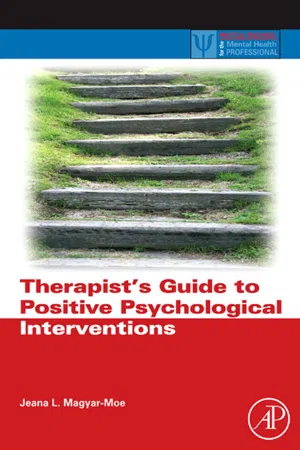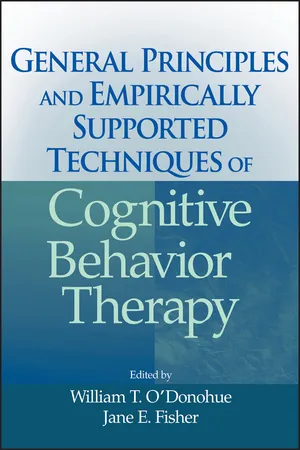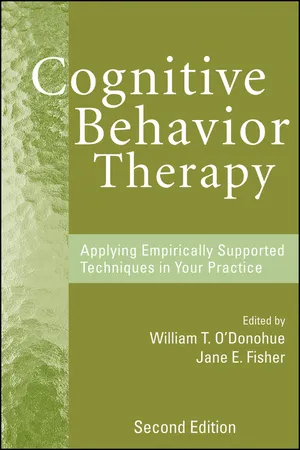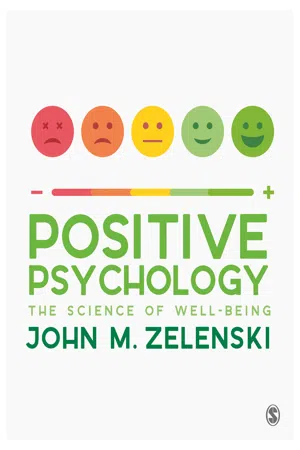Psychology
Positive Psychology
Positive Psychology is a branch of psychology that focuses on the study and promotion of positive emotions, strengths, and well-being. It seeks to understand and cultivate human flourishing, resilience, and optimal functioning. Unlike traditional psychology, which often focuses on pathology and dysfunction, positive psychology emphasizes the positive aspects of human experience and aims to enhance individuals' quality of life.
Written by Perlego with AI-assistance
Related key terms
11 Key excerpts on "Positive Psychology"
- Jeana L. Magyar-Moe(Author)
- 2009(Publication Date)
- Academic Press(Publisher)
Chapter 1. What is Positive Psychology and Why is it Important?Positive Psychology is the scientific study of optimal human functioning, the goals of which are to better understand and apply those factors that help individuals and communities to thrive and flourish. Perusal of the literature on Positive Psychology reveals many potential applications of the emerging research for a diversity of people within a wide variety of settings (Linley and Joseph, 2004 ; Snyder and Lopez, 2002, 2007 ). There seems to be no better fit, however, for Positive Psychology than within the therapy room. Indeed, research to date supports the notion that client conceptualizations and the incorporation of exercises informed by Positive Psychology can provide lasting positive outcomes for therapy clients (Duckworth et al., 2005 ; Seligman et al., 2005, 2006 ). In this text, strategies and exercises that therapists can use to begin incorporating Positive Psychology into their work with clients are provided.1.1. The History of Positive Psychology
In his 1998 presidential address to members of the American Psychological Association, Martin Seligman put a call out to applied psychologists to return to their roots and focus on not only curing mental illness, but also on making the lives of people more productive and fulfilling, and identifying and nurturing talent (Seligman and Csikszentmihalyi, 2000 ). Indeed, these were the main foci of applied psychologists prior to World War II. After the war, however, the emphasis shifted to curing mental illness with the other two aims almost completely forgotten. Such a change in focus is understandable, given the number of soldiers coming back from war with psychological problems and the resulting issues they and their loved ones faced as they tried to reorient themselves to civilian life. Following these societal changes, the development of Veterans Administration Hospitals proliferated, as did the availability of research funding by the National Institute of Mental Health for those researching cures for mental illness (Seligman and Csikszentmihalyi, 2000- William T. O'Donohue, Jane E. Fisher, William T. O'Donohue, Jane E. Fisher(Authors)
- 2009(Publication Date)
- Wiley(Publisher)
47 Positive Psychology: A BEHAVIORAL CONCEPTUALIZATION AND APPLICATION TO CONTEMPORARY BEHAVIOR THERAPY Alyssa H. Kalata and Amy E. NauglePositive Psychology is an emerging subfield within the broader field of psychology that is concerned primarily with the study of how individuals, families, communities, and institutions achieve optimal levels of functioning under normal circumstances (Gable & Haidt, 2005; Seligman & Csikzentmihalyi, 2000). Positive Psychology is typically concerned with three main areas of inquiry: (1) positive emotion and/or positive subjective experience (e.g., happiness, hope, flow, well-being), (2) positive individual traits, strengths, virtues, and/or characteristics (e.g., creativity, wisdom, bravery, kindness, leadership, spirituality, patience, humor), and (3) positive institutions and/or groups and the characteristics associated with them (e.g., altruism, responsibility, work ethic, civility) (Bacon, 2005; Duckworth, Steen, & Seligman, 2005; Harris, Thorensen, & Lopez, 2007; Seligman & Csikzentmihalyi, 2000; Seligman, Steen, Park, & Peterson, 2005; Sheldon & King, 2001). These areas of study are fairly unique within the field of psychology, in that they do not focus on psychological dysfunction and the elimination of symptoms, nor are they framed from the perspective of the medical model (Cowen & Kilmer, 2002; Seligman, et al., 2005).Although the definition of Positive Psychology seems relatively clear, concern has been expressed that the definition of Positive Psychology is in fact inconsistent and overly broad. Definitions of Positive Psychology have included a variety of terms and phrases, such as assets, strengths, well-being, positive character traits, potentials, motives, capabilities, positive emotions, virtues, and positive institutions- eBook - ePub
Positive Psychology
The Basics
- Rona Hart(Author)
- 2020(Publication Date)
- Routledge(Publisher)
The field of Positive Psychology at the subjective level is about valued subjective experiences: Wellbeing, contentment, and satisfaction (in the past); hope and optimism (for the future); and flow and happiness (in the present). At the individual level, it is about positive individual traits: the capacity for love and vocation, courage, interpersonal skill, aesthetic sensibility, perseverance, forgiveness, originality, future mindedness, spirituality, high talent, and wisdom. At the group level, it is about the civic virtues and the institutions that move individuals toward better citizenship: Responsibility, nurturance, altruism, civility, moderation, tolerance, and work ethic.(p. 5)In line with this depiction, Gable and Haidt (2005) defined Positive Psychology more concisely as “the study of the conditions and processes that contribute to the flourishing or optimal functioning of people, groups, and institutions ” (p. 104).Finally, Lomas, Hefferon, and Ivtzan (2014a) concentrated on its applied side and defined Positive Psychology as “the science and practice of improving wellbeing ” (p. ix).As can be seen from these definitions, there are repeated core themes around which there is consensus among scholars, particularly regarding its focus on wellbeing, its scientific grounding, and targeting people who are considered psychologically healthy.However there are also some variations in emphasis, mainly around the depiction of its remit, which is still an area of disagreement.The mission of Positive Psychology
The grand vision of Positive Psychology was highly ambitious: “To catalyse a change in the focus of psychology from preoccupation only with repairing the worst things in life to also building positive qualities” (Seligman & Csikszentmihalyi, 2000, p. 5). - eBook - ePub
Cognitive Behavior Therapy
Applying Empirically Supported Techniques in Your Practice
- William T. O'Donohue, Jane E. Fisher, William T. O'Donohue, Jane E. Fisher(Authors)
- 2008(Publication Date)
- Wiley(Publisher)
43 Positive Psychology: A BEHAVIORAL CONCEPTUALIZATION AND APPLICATION TO CONTEMPORARY BEHAVIOR THERAPY Alyssa H. Kalata and Amy E. NauglePositive Psychology is an emerging subfield within the broader field of psychology that is concerned primarily with the study of how individuals, families, communities, and institutions achieve optimal levels of functioning under normal circumstances (Gable & Haidt, 2005; Seligman & Csikzentmihalyi, 2000). Positive Psychology is typically concerned with three main areas of inquiry: (1) positive emotion and/or positive subjective experience (e.g., happiness, hope, flow, well-being), (2) positive individual traits, strengths, virtues, and/or characteristics (e.g., creativity, wisdom, bravery, kindness, leadership, spirituality, patience, humor), and (3) positive institutions and/or groups and the characteristics associated with them (e.g., altruism, responsibility, work ethic, civility) (Bacon, 2005; Duckworth, Steen, & Seligman, 2005; Harris, Thorensen, & Lopez, 2007; Seligman & Csikzentmihalyi, 2000; Seligman, Steen, Park, & Peterson, 2005; Sheldon & King, 2001). These areas of study are fairly unique within the field of psychology, in that they do not focus on psychological dysfunction and the elimination of symptoms, nor are they framed from the perspective of the medical model (Cowen & Kilmer, 2002; Seligman, et al., 2005).Although the definition of Positive Psychology seems relatively clear, concern has been expressed that the definition of Positive Psychology is in fact inconsistent and overly broad. Definitions of Positive Psychology have included a variety of terms and phrases, such as assets, strengths, well-being, positive character traits, potentials, motives, capabilities, positive emotions, virtues, and positive institutions - eBook - ePub
Positive Art Therapy Theory and Practice
Integrating Positive Psychology with Art Therapy
- Rebecca Ann Wilkinson, Gioia Chilton(Authors)
- 2017(Publication Date)
- Routledge(Publisher)
as a result of them . In fact, one could paradoxically be quite ill and impaired in some ways and yet thriving in others.Disconcerted but also intrigued by the disruption of some of our fundamental assumptions about therapy, change, and human nature, we set about exploring Positive Psychology more deeply. This included looking at current literature in Positive Psychology, but also relevant material emerging in art therapy, education, and other related fields. It also involved looking back over the historical context surrounding the formation of this “new” field and the theoretical foundations upon which it is grounded.In the next few chapters, we share some of what we discovered. We have tried to distill what, for us, has taken over ten years to learn. For some of you, this material may be redundant. On the other hand, perhaps it can serve as a useful refresher and set the stage for exploring art therapy from a Positive Psychology perspective. We felt that that could best be done by first describing the circumstances around which Positive Psychology emerged. Especially because, despite being seasoned clinicians as well as art therapy educators ourselves, we were often surprised by gaps in our knowledge or misconceptions that we had about the historical, social, economic, cultural, and political factors that led to development of different psychological schools of thought and that shaped mental health practices today, in general, let alone in the field of Positive Psychology.p.10 Positive Psychology DefinedPositive Psychology, also known as the science of wellbeing , is the study of human potential and optimal functioning. It is an in-depth exploration of the conditions and processes that allow individuals and communities to flourish and thrive (Seligman & Csíkszentmihályi, 2000). The field was christened in 1998 when Martin Seligman (1999), in his role as the president of the APA, identified that although we had made tremendous advances in understanding mental illness and reducing suffering, we had not devoted equal resources to exploring what is positive and functional in our lives. Positive psychologists have set about correcting this imbalance—not to diminish or replace the importance of addressing and attending to pathology and pain—but to complement this with an exploration of healthy, adaptive functioning. They wanted to establish for mental health the same depth and breadth of research, theory, and practical application as has been done for mental illness - eBook - ePub
Frameworks for Practice in Educational Psychology, Second Edition
A Textbook for Trainees and Practitioners
- Barbara Kelly, Lisa Marks Woolfson, James Boyle(Authors)
- 2016(Publication Date)
- Jessica Kingsley Publishers(Publisher)
CHAPTER 14 Positive Psychology as a Framework for Practice Stephen Joseph IntroductionThe aim of this chapter is to discuss the application of the Positive Psychology framework to educational psychology, and in particular to reflect on how Positive Psychology leads us to reflect on the fundamental assumptions underpinning practice. There have always been psychologists who have been interested in understanding optimal functioning, most notably the humanistic psychologists, but it is only within the past two decades that interest in this has developed among a new generation of psychological practitioners and scholars who identify themselves as positive psychologists. The term ‘Positive Psychology’ was used by Martin E.P. Seligman in his presidential address to the American Psychological Association (APA) (Seligman 1999) in order to describe his vision for the future of psychological science. Seligman realised that psychology had largely neglected the latter two of its three pre-Second World War missions: curing mental illness, helping all people to lead more productive and fulfilling lives, and identifying and nurturing high talent. It was with that realisation that Seligman stated: ‘The aim of Positive Psychology is to begin to catalyze a change in the focus of psychology from preoccupation only with repairing the worst things in life to also building positive qualities’ (Seligman and Csikszentmihalyi 2000, p.5).In this chapter I will consider the implications of Positive Psychology for educational psychologists (EPs). I will begin by discussing, first, practical applications of Positive Psychology to educational psychology – in particular, how Positive Psychology can inform the everyday practice of educational psychology through its explicit focus on the positive side of human experience. I will then go on to consider theoretical perspectives about how Positive Psychology provokes re-examination of the fundamental assumptions underpinning the practice of educational psychology. - eBook - ePub
Positive Psychological Science
Improving Everyday Life, Well-Being, Work, Education, and Societies Across the Globe
- Stewart I. Donaldson, Mihaly Csikszentmihalyi, Jeanne Nakamura, Stewart I. Donaldson, Mihaly Csikszentmihalyi, Jeanne Nakamura(Authors)
- 2020(Publication Date)
- Routledge(Publisher)
University courses and graduate programs in Positive Psychology are now thriving, including a highly visible professional master’s program at the University of Pennsylvania under the leadership of Professor Seligman and the first doctoral programs in Positive Psychology at Claremont Graduate University under the leadership of Professors Csikszentmihalyi, Donaldson, and Nakamura. The scholarly Journal of Positive Psychology was established in 2006, and the International Positive Psychology Association (IPPA) was formed in 1998 as a professional home for more than 3,000 professionals worldwide who are interested in Positive Psychology. The Rapid Expansion of Positive Psychological Science “Positive Psychology” seems to have become an umbrella term for studies on strengths, virtues, excellence, thriving, flourishing, resilience, optimal functioning in general, and the like. Some have called it a fresh lens or a new way of focusing research on human and organizational behavior. This organized positive orientation to research, application, and scholarship has quickly escaped the disciplinary confinement of psychology and has spread rapidly across a wide range of disciplines and professions (Donaldson & Ko, 2010; Donaldson, Donaldson, & Ko, Chapter 7 in this volume; Warren, Donaldson, Lee, & Donaldson, 2019) - eBook - ePub
Positive Psychology
The Science of Well-Being
- John Zelenski(Author)
- 2019(Publication Date)
- SAGE Publications Ltd(Publisher)
Founders of the Positive Psychology movement emphasized its differences from traditional psychology (Seligman & Csikszentmihalyi, 2000). This was useful in defining and growing their movement (Yen, 2010), but was also met with some ambivalence, irritation, and critique (Held, 2005; Taylor, 2001). Some felt unfairly excluded, and others pointed to a much longer history of positive topics in psychology. It is clear that Positive Psychology overlaps considerably with other areas, and many who contribute to it are ambivalent about identifying (exclusively) as positive psychologists. For example, a few years into the movement even its proponents Gable and Haidt (2005) expressed the sentiment, “We do not think of ourselves as rebels, and many of us rarely if ever refer to ourselves as ‘positive psychologists.’ We merely find that the Positive Psychology movement helps us study our topics more effectively” (p. 107). Many who contribute to Positive Psychology see themselves as belonging more to other areas, while having an interest in studying the good life.Nearly every sub-discipline in psychology rubs up against Positive Psychology. For example, personality psychology studies the characteristics that differentiate very happy from less happy people. Like Positive Psychology, health psychology is concerned with human wellness. Both areas share the core notion that health is more than absence of illness, and both have an interest in how prevention can keep people well (e.g. offering support before something goes wrong). Social psychologists have long studied cooperative and prosocial (e.g. helping) behaviour. Cognitive psychology, with its work on creativity, intelligence, and optimal learning strategies, has learned much about clearly positive, valued topics. Developmental psychologists are interested in how all these things unfold over the lifespan. Organizational psychologists and educational psychologists study and apply positive topics in their institutional contexts. Indeed, Positive Psychology seems to draw from and interact with all areas.Distinguishing Positive Psychology from Humanistic Psychology
The comparison with humanistic psychology, as a similar movement and sub-discipline, deserves special mention. You may have heard of Maslow’s (1943) hierarchy of needs, typically depicted in a pyramid-shaped diagram and topped by the uniquely human need to self-actualize. Carl Rogers (2007) similarly emphasized people’s individual uniqueness and the importance of unconditional acceptance from others (‘positive regard’) in fostering healthy development of the true self. Maslow and Rogers are well-known leaders in humanism, an approach to psychology that shares much with Positive Psychology. That is, both are prone to an optimistic perspective on human nature. Both focus on helping people thrive, going beyond merely alleviating suffering. Thus, some have argued that Positive Psychology merely re-branded a long tradition that includes humanistic psychology (Taylor, 2001). Similarly, existential psychology, with a focus on how people find meaning in their lives, is an important predecessor to central topics in Positive Psychology. - eBook - ePub
- Acacia Parks(Author)
- 2014(Publication Date)
- Routledge(Publisher)
Sue (2003) notes that some of the skills or strengths that may develop for people who overcome racial or cultural adversity include heightened perceptual wisdom (i.e., the ability to correctly perceive underlying motives, intentions, and meanings of others), the ability to rely on non-verbal or contextual meanings, and bicultural flexibility (i.e., openness to multiple worldviews, sensitivity to other’s viewpoints, and behavioral flexibility). Such flexibility often leads to a broadened world view, an appreciation for the strengths and weaknesses of all people, comfort with cultural differences and better effectiveness in relating to those of diverse backgrounds, an enhanced sense of self-fulfillment, and a sense of connection and commitment to better citizenship and social responsibility.Positive Psychology can also be applied within courses on multiculturalism through such exercises as having students examine all aspects of their own cultural identities via use of the ADDRESSING model (Hays, 1996, 2001). ADDRESSING is an acronym, with each letter representing one aspect of culture as follows: Age and generational influences, Disability status (developmental), Disability status (acquired), Religion and spiritual orientation, Ethnicity, Sexual orientation, Socioeconomic status, Indigenous heritage, National origin, and Gender. Students should be challenged to consider what personal strengths, interpersonal supports, culturally-related knowledge and skills, and environmental strengths have developed for them due to their cultural make-up.Positive Psychology in introduction to counseling skills and techniques coursesPositive Psychology can be incorporated into counseling skills courses in some of the same ways as previously noted within the contexts of abnormal psychology or psychological assessment classes. More specifically, people-first language, the four-front assessment approach (Wright & Lopez, 2002), and the complete state model of mental health (Keyes & Lopez, 2002) are all applicable to counseling. Several other concepts from Positive Psychology also have applicability when it comes to teaching students basic counseling skills, including active-constructive responding (Gable, Reis, Impett, & Asher, 2004), positive empathy (C.W. Conoley & J.C. Conoley, 2009), and highlighting client strengths and resources throughout the counseling process.According to Gable et al. (2004), there are four possible ways in which one can respond to the good events in the lives of those with whom one interacts: (1) active-constructive (responding enthusiastically); (2) passive-constructive (happy, but downplayed); (3) active-destructive (pointing out the downside); (4) passive-destructive (lacking interest). Of the four styles, only the active-constructive style benefits both the individual one is interacting with, as well as the relationship between the two parties. Students should be exposed to the idea of active-constructive responding and encouraged to respond in this manner to the good news, positive experiences, and victories that they hear in the stories that their clients tell. Indeed, responding in this manner serves to strengthen the ever-important working alliance within the therapeutic relationship. - eBook - ePub
Education and Schmid's Art of Living
Philosophical, Psychological and Educational Perspectives on Living a Good Life
- Christoph Teschers(Author)
- 2017(Publication Date)
- Routledge(Publisher)
Chapter 5 , can broaden this understanding and provide a more holistic view on the topic.4.1 The relevance of Positive Psychology for an art of living
Psychology is traditionally a science concerned with the question of what is wrong with people. The art of living, on the other hand, is more concerned about how to get it right. Therefore, it seems necessary to give a short introduction about how these two areas are connected and why this connection is important for an educational approach.Beginning in the middle of the 20th century an increasing number of psychologists shifted their focus of research from the pathological question of “What is wrong with humans?” to the more positive research question of “What is right?”. This new focus became known later as the field of Positive Psychology, which was introduced under this name around the year 2000 by Martin Seligman and Mihaly Csikszentmihalyi, who have since been known as the founders of this new area of psychological research. The term Positive Psychology subsumes a range of areas, including flow, positive emotions, wisdom and knowledge, happiness and well-being, creativity, strengths and values, (life) goals, positive coping strategies, humour and many more (Boniwell 2008, 1–6). As this area of research has grown significantly in the last 15 years, the focus in this chapter lies on Martin Seligman’s (2010) book Authentic Happiness, which provides a good overview of Positive Psychology, and the book Flow from Michael Csikszentmihalyi (2008), which offers insights in one of the main theories for happiness and well-being. Csikszentmihalyi also includes some thoughts about the history and development of happiness in humanity.The contribution Positive Psychology can make to an educational approach to the art of living is manifold and singular at the same time. The main focus of Positive Psychology lies in explaining and increasing happiness and positive emotions, which appears to be a singular topic. On the other hand, research shows that such an increase has a positive effect on health, performance, creativity and coping with negative emotions, and it also prolongs life1 - eBook - ePub
Positive Psychology in Christian Perspective
Foundations, Concepts, and Applications
- Charles Hackney(Author)
- 2021(Publication Date)
- IVP Academic(Publisher)
development of the whole child, affecting intellectual outcomes as well as motivation, self-concept, and the vitality and integrity of self-development. (Ryan & Deci, 2017, p. 353)Researchers have looked both at how schools can serve as venues for positive development and at how the findings of positive psychologists might be employed to improve students’ performance and adjustment (Gilman et al., 2009; Wade et al., 2015). Many of the topics within Positive Psychology that we have already covered in this book are represented here, with educational applications flowing from researchers’ more general theoretical and empirical work. For example, based on what we have seen regarding the value of positive subjective states, many teachers have begun encouraging happiness and flow (Baylus, 2004). Conoley and Conoley (2009) suggest that educators increase flow among students by assigning work that is optimally challenging, meaningful, and intrinsically motivating. We will begin our coverage of positive education by looking at a specific positive psychological theory that has been applied at multiple levels of education and then cover some programs that are grounded in theories we have seen earlier in this text.SELF- DETERMINATION THEORY
Self-determination theory (SDT) “is an empirically based, organismic theory of human behavior and personality development” that “is centrally concerned with the social conditions that facilitate or hinder human flourishing” (Ryan & Deci, 2017, p. 3). Although SDT predates the advent of the Positive Psychology movement with its emphasis on well-being, personal growth, and improved performance, SDT has found a natural home among positive psychologists (Ryan & Deci, 2000; Sheldon & Ryan, 2011). SDT is an “organismic” theory, meaning that it begins with the assumption that humans actively engage with their environments, integrating their experiences into a coherent and growing self (Deci & Ryan, 1985). This connects SDT to humanistic psychology (see chapter one
Index pages curate the most relevant extracts from our library of academic textbooks. They’ve been created using an in-house natural language model (NLM), each adding context and meaning to key research topics.










